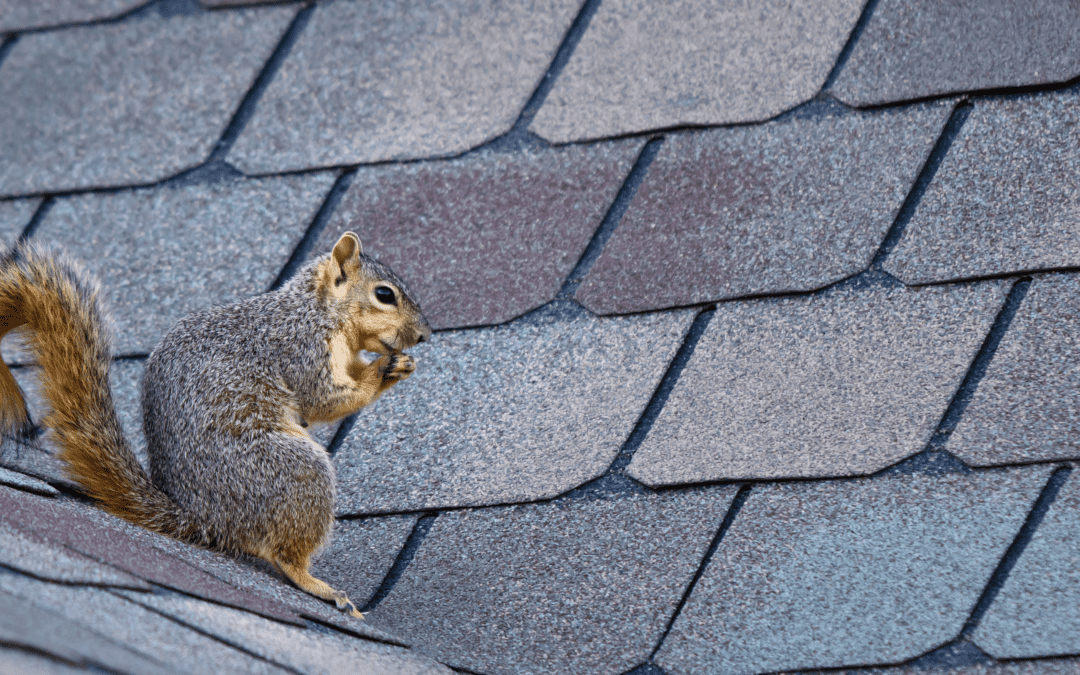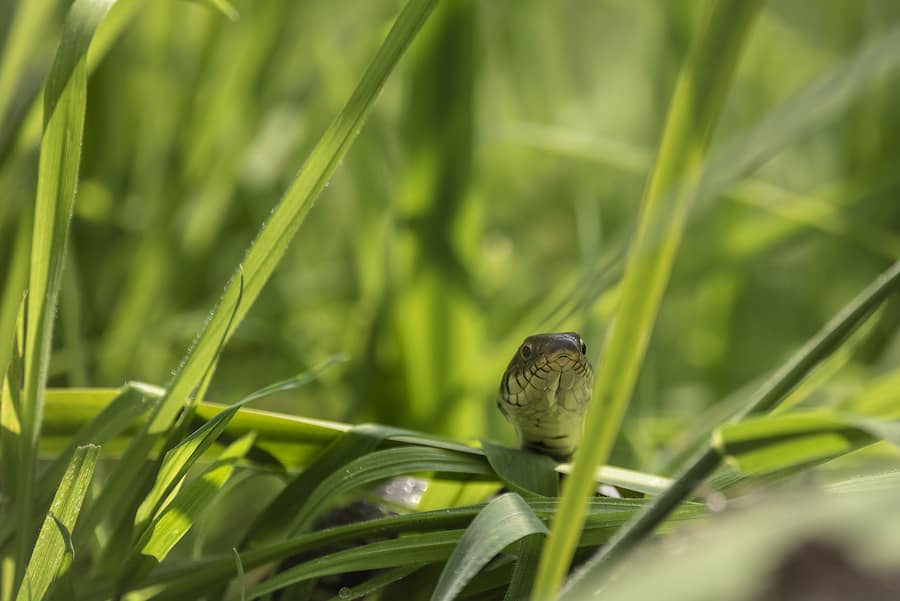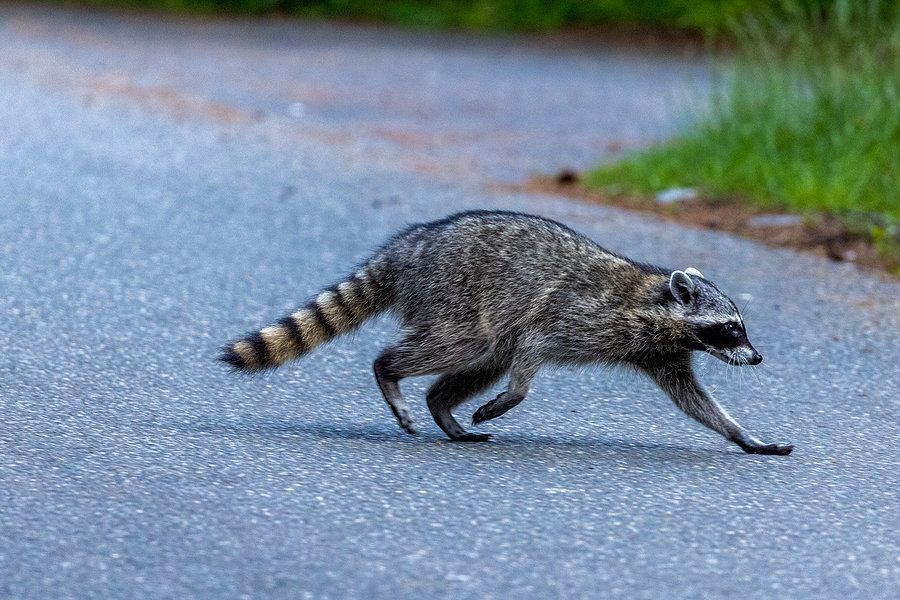READY TO GET STARTED?
REQUEST A FREE ESTIMATE
Fill out the form below or call (888) 466-7849 for a free, no-obligation estimate.

August is here and as much as we don’t want to think about it, fall is right around the corner. As the days begin to get shorter and temperatures drop, wildlife creatures begin to prepare for the fall and winter seasons. Fall is the time when wildlife search for warm shelter and begin to stock up on food, sometimes leading them right to your home!
Here are some of the most common wildlife critters that can find refuge in your home for winter, along with some ways to prevent them from taking up residence in your home.
Squirrels like to “fatten” up in the fall as they get ready for the colder months. They often seek shelter in attics where they will make their nests and store their food. They are especially hazardous in homes because they have a tendency to chew through wires and wood, creating significant damage to your home.
Some ways to prevent squirrels:
Like squirrels, raccoons also like to “fatten” up for the winter. Raccoons are nocturnal, which means they are more active at night. When the weather gets cooler, this causes raccoons to become more active and creative in their search for food. They will often find food in your trash cans and home and can often enter your house through the roof. They are known to seek shelter in either your attic or crawl space.
You can prevent raccoons by:
Rodents, like mice and rats, will begin to be more active in the fall and you can usually hear them in your walls or attic. They seek shelter in your home because it supplies them with an available food supply throughout the winter.
Prevent rodents this fall by:
Bats
Once the temperature dips below 45 degrees Fahrenheit, bats will begin their hibernation. While some species of bats do migrate south once the weather cools off, some will be in search of warm, dark spaces to roost that are hidden from predators. Unfortunately, they will often roost in the attic or chimney of your home.
You can prevent bats by:
Wildlife removal can be a difficult task to handle on your own, as there are some regulations for certain species. It is often best left to the professionals. If you suspect you have a wildlife problem, contact your local professional wildlife control company. These professionals will inspect your home to identify the animal problem. They will also provide you with the best plan of action to remove nuisance wildlife and prevent it in the future.

As the season shifts from summer to early fall, cooler weather is around the corner. Many pests begin the hustle and bustle of preparing for winter – scavenging and storing food, finding a place to hibernate, or making their way into your home to overwinter. This time of year sees an increase in one pest in particular – snakes! Fall is a time for high snake activity and encounters with humans become more common.
There are many reasons snake control is important in the fall. As the leaves begin to change colors to red, orange, and brown and fall to the ground, they provide the ideal camouflage for snakes. Fall is also the time snakes begin to prepare for brumation and/or hibernation. Most snake species breed in the spring and eggs are hatched by the time autumn rolls around. These juvenile snakes are curious and more likely to be seen by humans. There are 6 venomous snake species in the southeastern United States and each of them actually breed in the fall. This means this time of year males will be actively seeking females to breed with, increasing your chance of an encounter with them. Overdevelopment in many areas has also depleted the natural habitats of many snakes, also increasing their chances of encounters with humans.
Because we see such an increase in snake activity during the fall, snake control becomes much more important. Here are some of our favorite snake prevention tips you can utilize this snake season.
Are Mosquitoes Still Active in the Fall?
What Attracts Centipedes To Your Home?

Seeing any wildlife creature in your South Florida home is always alarming! While both are harmful to our home and the health of our family. These creatures will contaminate homes, chew wires, and transmit diseases to humans and pets. It’s important to understand their key differences to help prevent both rodents.
House mice are smaller than rats, ranging from four to six inches in length, and can be light grey, white, or brown. While rats are double the length of the average house mice, Norway rats are around 10 inches long. A difference seen between the two rodents are their tails. Mouse tails are equal in length to their body and are thin, long, and hairy. Rat tails can be 7” to 9” in length and are long, thick, scaly, and hairless.
If you have rodent infestation, you’ve probably seen their droppings. The difference between rat and mice droppings is noticeably different. Mice have smaller droppings, only about an eighth to a quarter of an inch long. Rat droppings are larger, about a half to three-quarters of an inch long.
Both rats and mice will happily nest inside or around your property, but their difference is the location they choose to nest in. Mice are great at climbing, typically making their nests in wall voids, attics, sheds, cabinets, and barns. While rats, such as Norway rats, will choose to live in burrows underground like crawlspaces, attics, and basements. Other rats, such as roof rats, are also great climbers but prefer to habitat in upper parts of buildings, trees, or attics.
Whether you’re dealing with a mouse or rat, proper identification and treatment are essential to remove them. It’s best to contact your local South Floria pest control company who will identify the rodent, locate entry points, and provide a treatment and prevention plan.

While most snakes you encounter are harmless, many of us still don’t want to come across one in our yard or home. While our first instinct may be to run, most snakes are actually beneficial to have around – they help keep other pest populations under control (rodents, frogs, etc.).
Snakes will come into your yard in search of 2 things: shelter and food. Snakes will seek out shelter to have a place to rest, breed, and hunt. Common places snakes are found include overgrown grass, dense brush or shrubs, leaf piles, rock piles, compost, or areas with moisture like underneath bird baths, around leaky faucets and hoses, or near ponds or swimming pools. Snakes will also come looking for food. Snakes love to eat rodents, moles, frogs, fish, snails/slugs, and other small insects.
If you prefer not to encounter snakes around your home, here are 7 natural ways you can keep snakes away.
Snakes will come around looking for food so if your home provides them with that, you’ll be more likely to encounter them. Getting rid of these food sources will encourage snakes to move along in search of something to eat. Make sure common pests that snakes like to eat are kept under control. Scheduling routine pest control can help with this.
Snakes are also attracted to areas with a lot of moisture. Eliminate standing water in your yard where possible. Repair leaky faucets and replace leaky hoses. Keep pools, ponds, and other water features maintained. If using sprinklers, make sure they are running in the morning so the water has time to soak in or evaporate before it gets dark. This helps keep soil in your yard from being too wet.
Snakes will look for places around your home to hide so they can breed and rest. Get rid of coiled hoses or use hose boxes. Avoid using rock piles in your landscaping, if possible. Store firewood in boxes or elevate it when possible. Keep your grass mowed and dense brush cleared out. Seal off or add fencing to any open areas under sheds or other buildings. If you are using snake-proof fencing, make sure it is made of steel mesh or plastic sheeting, it is at least 3 feet high and 4 feet deep, it is flush with the ground, and it is angled outward.
Some plants are known to repel snakes. Try to incorporate these plants into your landscape design where possible. Common snake-repelling plants include marigolds, lemongrass, Mother-in-Law’s tongue, wormwood, onion, and garlic.
Gophers, moles, and voles dig burrows across your yard. Once they’ve been eliminated, these old gopher holes and burrows can remain on your property. Snakes will commonly use them for shelter as they provide a great place for them to hide, rest, and breed. Fill in any of these holes and burrows with dirt or gravel. This will help deter snakes from using them.
Snakes have a few natural predators that can help keep them away. Common snake predators include cats, raccoons, pigs, turkeys, guinea hens, and foxes. Keeping any of these animals around your home will help deter snakes from coming near. You can also buy fox urine and sprinkle it around your property to help deter snakes, as well.
There are several natural products that are known to repel snakes. These natural snake repellents can be used around the perimeter of your property, around pools, along the edges of ponds, and anywhere else you have noticed snake activity.
Despite our best efforts, snakes can still make their way into our yards and homes. If you have a problem with snakes, contact your local pest control company who specializes in snake removal who can help you properly identify the type of snake you have (venomous vs nonvenomous) and help safely and humanely remove it from your property.
How Do Cockroaches Get Into the House?
Identify and Prevent Brown Recluse in Your Tennessee Home

Purchasing and owning a home is a serious investment for every homeowner. Ensuring that it’s aesthetically pleasing, in good repair, and healthy is at the top of our minds. The last thing we want to deal with is a pest infestation, though it’s likely to happen from time to time. While spotting one or two pests is not usually a big deal, if the problem becomes bigger than we can handle, it could be time to call an exterminator. Check out our top 5 signs that it’s time to contact your local South Florida pest control company.
Finding rodent droppings is one of the first indications that a rat is inside your home. Rat droppings are found in dark, undisturbed places in the home, including basements, attics, or crawlspaces. If these creatures find their way inside, they can cause serious destruction, such as chewed electrical wires that can lead to house fires. They’re also known to carry diseases, putting your family’s health at risk.
Nests are usually found in basements, attics, or even old cabinets. Pests such as mice, birds, or rats will nest in your home to find a safe place to search for a food source, keep warm, and breed. Finding a nest usually means that the pest population inhabiting your home is getting larger.
Have you ever woken up in the middle of the night to scratches, tapping, or squeaking coming from the walls or attic? No, you are not in a horror movie, it’s an indication of a rat, rodent, bird, or termite infestation. These sounds can follow with strange, alarming smells such as the pest’s droppings or urine.
If you start to notice your home or the items in your home are damaged, it’s a sign that pests have snuck in. Spotting chewing or gnawing marks on our furniture, clothes, or walls indicates that rodents such as rats or mice are inside. Ants and termites are likely to destroy wood throughout the home, affecting your home’s structural integrity. Other pests, such as bed bugs, will often eat our bedsheets and mattresses.
Many pests can be easily removed or controlled through some do-it-yourself pest control. But, sometimes, as much as we try to remove these pests ourselves, it might be time to call in the professionals for routine pest control service. Pest Control includes a thorough inspection of your home, pest identification, locating pest entry points, and ongoing treatment and pest prevention. Request a free pest control estimate now to get started.

While rodents are known to infest during the winter months that doesn’t mean they won’t sneak into your Florida home during the summer months. Once inside, rodents can cause significant damage to your home, including destroying insulation, chewing electrical wires, and leaving their droppings behind. Every homeowner should be aware of the types of rodents popular to their area and how to prevent them from infesting.
Norway rats are larger rats with hairless tails and grey coloring. These rats tend to be ground dwellers, meaning they like to habitat in sewers or burrows, especially within the coastal communities in Florida. You can usually find their nests near homes or businesses, as they will forage for food in open garbage cans. These rats find their way inside through entry points close to the ground, such as your indoor plumbing drain system. Once infested, a female Norway rat will produce tons of offspring, growing an infestation very quickly!
Smaller than Norway rats, a roof rat can weigh a half a pound or less! These rats are usually identified by their tail as it is longer than the distance of their body. Because of their slender body and longer tail, they are great at climbing, utilizing this skill to climb onto roofs through trees, shrubs, or power lines, typically nesting in the attics. These rats tend to stay in a familiar area, avoiding exploration. If an area provides shelter and a food source, they will stay close or habitat there.
Ranging from 5 to 7 inches in length, a house mouse has a long, rough tail with light brown to black coloring. These creatures are also known to be great climbers with a keen sense of hearing, touch, taste, and smell! The house mouse is known to live around homes, farms, and businesses. When they find a food source, they will establish a territory 10 to 30 feet in size. If they infest a home, they will gnaw on surfaces to wear them down, causing extensive damage and contamination.
If you have a rodent infestation or want to get on top of rodent prevention, reach out to your South Florida wildlife control company for a Rodent Control Inspection and Estimate.

Florida continues to be a hot spot for food and dining. With popular tourist and local spots in Fort Myers, Bonita Springs, Naples, Miami, and many more, the restaurant industry continues to boom. As summer approaches, we can expect an uptick in restaurant reservations from those visiting. Now is the perfect time to ensure that your restaurant has placed proper preventative measures to avoid rodents.
This one might be obvious, but it is one of the most crucial factors in avoiding rats and mice. Food scraps and leftovers that restaurants discard is a major attraction to these creatures. Look to remove all leftover food as soon as possible, emptying the trash cans several times a day. You will want to ensure that all trash cans and dumpsters have secure lids. Look to position the outside trash containers away from your restaurant building and entrances to help discourage rodents from entering.
In a restaurant, it’s impossible to remove all food and water that rodents are attracted to. However, you can protect and secure the food inside your restaurant. Look to cover all food until it is ready to be prepared and ensure that you’re dining, and kitchen areas are clean throughout the day. If any food spills occur, make sure you clean them up as soon as possible, remembering to check crumbs settled into crevices and along baseboards.
Keeping your restaurant up to date in repairs will help to prevent rodents from entering. Rats can enter buildings through gaps small as a size of a quarter, while mice only need an opening the size of a dime! To help prevent their entry, make sure that all exterior cracks and crevices are sealed, install door sweeps, repair torn window screens, and fix any water leaks.
A rodent infestation can be extremely harmful to any business, risking a negative reputation in the process. Consider investing in Commercial Wildlife Control for your South Florida restaurant, as these professionals will provide your business with a customized prevention and treatment plan.

As much as we enjoy the beauty of birds, they can start to become a nuisance when they destroy our property. These creatures will often leave behind their droppings, harming your home and posing a health threat. Learn more about the hazards birds can pose to your home and how you can deter them away.
Seeing bird droppings all throughout our property is never ideal, causing considerable damage. Their droppings can corrode and stain roofing, gutters, paints, shingles, and more. Other bird damage includes electrical equipment, causing costly repairs. While their droppings can be overall irritating to clean, they are also known to carry over 60 diseases including E. coli, salmonellosis, and cryptococcosis.
When birds create their nest in your home, the location can cause noise and further damage. Their nests will clog gutters, cause roof damage, block chimneys or air ducks, ruin insulation, and more. Birds nest may also carry various pests such as lice, mites, and other insects that could potentially invade your home.
There are some easy, do-it-yourself preventative measures that every homeowner can place around their property to help deter birds away including:
South Florida Pest Control Locations Near You

Raccoons are one of the most easily recognizable pests that homeowners deal with. These common wildlife are known for their distinctive black masks over their eyes and ringed tails. Raccoons have gray and black fur and are about the size of an average housecat or small dog. They have 5 fingers on each hand and are extremely coordinated. They are highly intelligent with excellent memories. Raccoons are found in every state of the US.
Raccoons are scavengers and mostly hunt for food at night. They will eat almost anything. They are also highly adaptable allowing them to live in a wide variety of habitats (urban, suburban, rural, forest, mountain, coastal, and more).
When raccoons nest in or near your house they can cause significant damage to both your property and your health. Their damage isn’t just limited to tipped over trashcans. In their search for a nesting site they will rip off shingles, fascia boards, and even chimney vents. Once inside your home, they can destroy insulation, chew through electrical wires, and contaminate your home with urine and feces. They will dig up your yard in search of grubs and even tear off decking to get under porches and decks.
Signs of raccoons on or near your property include:
Getting rid of raccoons can be difficult. They are crafty and can be difficult to trap. Here are some ways to prevent raccoons from taking over your home or yard.
Nearby food sources will attract females to the area to nest and also allow populations to grow rapidly. Eliminating food sources makes your property less attractive to raccoons and other wildlife. Make sure to use heavy trashcans with secure lids. You may consider putting your cans in a rack or tying them to a secure post to prevent tipping. If your lids aren’t secure, use bungee cord or wire to make sure lids are secure. Bring in pet food before nightfall. Try to deter raccoons from bird feeders by using raccoon-proof feeders, hanging from shepherd’s hooks, or bringing them in overnight. Pick up any fallen fruit or nuts from the ground. Consider installing fencing around gardens, ponds, or compost piles. Electric fence is preferable as raccoons can climb over or dig under regular fencing. Don’t intentionally feed raccoons as this will only attract more and increase the population.
Without a place to nest, raccoons will likely move on to a more hospitable environment. Clean up your yard and keep your grass mowed. Remove wood piles and thin out any overgrown shrubbery. Trim branches away from your roof, providing at least a 5′ gap between the roof and any trees. Get rid of any trellises or arbors that may allow access to your roof.
Raccoons like to nest in chimneys so make sure it is sealed when not in use with a chimney cap that is tightly secured. Make sure there are no animals inside your chimney before sealing it off. Inspect the exterior of your home and identify any other possible entry points, as well. Close off spaces under porches, decks, and sheds with wire mesh. Make sure the bottom edge of the wire is buried at least 6 inches deep and extends out at least 12 inches. Make sure to back-cover the wire with soil.
There are several repellents and products designed to scare raccoons with motion and light. Raccoons are highly intelligent and these products will only be effective until they realize there is no threat. Trapping can also be dangerous for homeowners as these nuisance wildlife carry a wide range of parasites and diseases that can be harmful to both humans and pets. Raccoons will bite or scratch if they feel threatened or if they have their young near them. They are known to carry rabies, roundworm, and canine distemper.
If you have an issue with raccoons or any other wildlife, consider contacting a professional pest control company who specializes in wildlife control and wildlife exclusion. They can identify where raccoons may be feeding or nesting and safely and legally trap and relocate them.
Identifying and Controlling Armyworms
How to Bring Your Lawn Back to Life This Spring